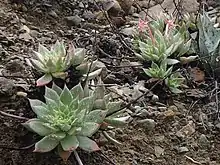| Cochimí liveforever | |
|---|---|
 | |
| Scientific classification | |
| Kingdom: | Plantae |
| Clade: | Tracheophytes |
| Clade: | Angiosperms |
| Clade: | Eudicots |
| Order: | Saxifragales |
| Family: | Crassulaceae |
| Genus: | Dudleya |
| Species: | D. cochimiana |
| Binomial name | |
| Dudleya cochimiana S.McCabe, 2022 | |
Dudleya cochimiana, commonly known as the Cochimí liveforever, is a species of succulent plant in the family Crassulaceae endemic to Cedros Island, a large island off of the coast of Baja California, Mexico.[1][2][3][4] It is a rosette-forming leaf succulent characterized by broad, green to white leaves, and flowers with white to pink petals. It can be found on rocky slopes and canyons along the island.[5]
Description
Dudleya cochimiana is a rosette-forming succulent with broad green leaves and white to pink flowers. It is endemic to Cedros Island, where it grows sympatric with 4 other species in the genus: Dudleya acuminata, Dudleya albiflora, Dudleya delgadilloi, and Dudleya pachyphytum.[1]
- Dudleya cochimiana differs from Dudleya acuminata with its larger rosettes with more leaves and its white to pink colored flowers, which are borne on pendent, lateral, or ascending inflorescences. Dudleya acuminata has yellow flowers borne upright.[1]
- Dudleya cochimiana differs from Dudleya albiflora, Dudleya delgadilloi, and Dudleya pachyphytum in its broad leaves, its flowers with erect petals with only slightly outcurving tips, and the pendent, lateral, or ascending presentation of the flowers.[1]
It is most similar to two species on the mainland of Baja California, namely Dudleya ingens and Dudleya gatesii.[1]
Dudleya cochimiana flowers from April through June.[1]
Taxonomy
Taxonomic history
This species was first known as Dudleya cedrosensis,[6] a name given to the plants by Reid Moran in his 1951 thesis on Dudleya.[7] The failure of the thesis to be published[8] meant that Dudleya cedrosensis was never a valid species,[6] as Moran had difficulty reconciling some morphological differences between plants on the island. Although distinct, it was often regarded as a synonym of Dudleya ingens, due to the type collection being later identified as D. ingens aff, and sometimes associated with Dudleya albiflora.[6]
In 2023, Stephen McCabe validly published and described Dudleya cochimiana in Madroño, which encompasses roughly the same plants Moran assigned to D. cedrosensis.[9]
Etymology
Stephen McCabe named the specific epithet cochimiana in recognition of the indigenous people of the region, and their language and territory. Cochimí is an extinct language group and a collective name for the various tribes of the indigenous peoples of Cedros Island and central Baja California.[1]
Distribution and habitat
Distribution
Dudleya cochimiana is endemic to Cedros Island, an island in the Pacific Ocean off of the coast of the central Baja California Peninsula. The island belongs to the state of Baja California, Mexico.[1]
Dudleya cochimiana is distributed on the eastern side of the island, where it is found from the beaches and then inland, where it reaches the Gran Cañón in the south and a large canyon under Pico Gill in the north, its distribution delimited by the ridgetops that divide the center of the island.[1][2]
Habitat
Dudleya cochimiana grows in a variety of habitats within its small distribution, being found in full sun to part shade on rocky slopes and rocky outcrops. It is sometimes associated with cryptogamic communities near the ridgetops.[1]
See also
Other insular endemic Dudleya of Baja California
References
- 1 2 3 4 5 6 7 8 9 10 McCabe, Stephen Ward (11 January 2023). "Dudleya Delgadilloi And Dudleya Cochimiana, Two New, Rare Species From Isla Cedros, Baja California, México". Madroño. 69 (2). doi:10.3120/0024-9637-69.2.191. ISSN 0024-9637. S2CID 255596246.
- 1 2 Oberbauer, Thomas A. (1987). Hochberg (ed.). "Floristic Analysis of Vegetation Communities on Isla de Cedros, Baja California, Mexico". Third California Islands Symposium: Recent Advances in Research on the California Islands. Santa Barbara Museum of Natural History, Santa Barbara, CA.: 115–131.
Dudleya cedrosensis Moran ined. Endemic and found in rocky slopes in the canyon near Pico Gill.
- ↑ Ratay, Sarah E.; Vanderplank, Sula E.; Wilder, Benjamin T. (2014). "Island Specialists: Shared Flora of the Alta and Baja California Pacific Islands". Monographs of the Western North American Naturalist. 7 (1): 161–220. doi:10.3398/042.007.0116. S2CID 85855995.
- ↑ Vanderplank, Sula; Rebman, Jon; Ezcurra, Exequiel (November 2018). "Checklist of the Plants of North Mexican Pacific Islands". Western North American Naturalist. 78: 674–698. doi:10.3398/064.078.0410. S2CID 91327690.
- ↑ Moran, Reid (25 June 1968). "Reid Moran 15154". CCH2 - Consortium of California Herbaria. San Diego Museum of Natural History. Retrieved 8 February 2022.
- 1 2 3 Eggli, Urs, ed. (2003). Illustrated Handbook of Succulent Plants: Crassulaceae. Berlin, Heidelberg: Springer Berlin Heidelberg. p. 96. doi:10.1007/978-3-642-55874-0. ISBN 978-3-642-62629-6. S2CID 36280482.
- ↑ Moran, Reid V. (1951). "A Revision of Dudleya (Crassulaceae)". Dissertation (Unpublished). University of California: 231–233.
- ↑ Moran, Reid (1987). "Dudleya rigida Rose". Cactus and Succulent Journal of America. 1987 Sep-Oct: 187–194.
Once upon a time I wrote a thesis about Dudleya (Moran 1951). This was in tended as an educational exercise, and it was; but most educational of all was finding out how much I still had to learn - which so impressed me that I never published the thesis.
- ↑ "UC Santa Cruz botanist names two rare succulent species". Santa Cruz Sentinel. 2 February 2023. Retrieved 2023-03-13.
External links